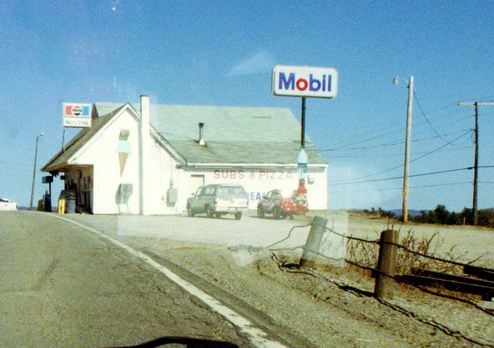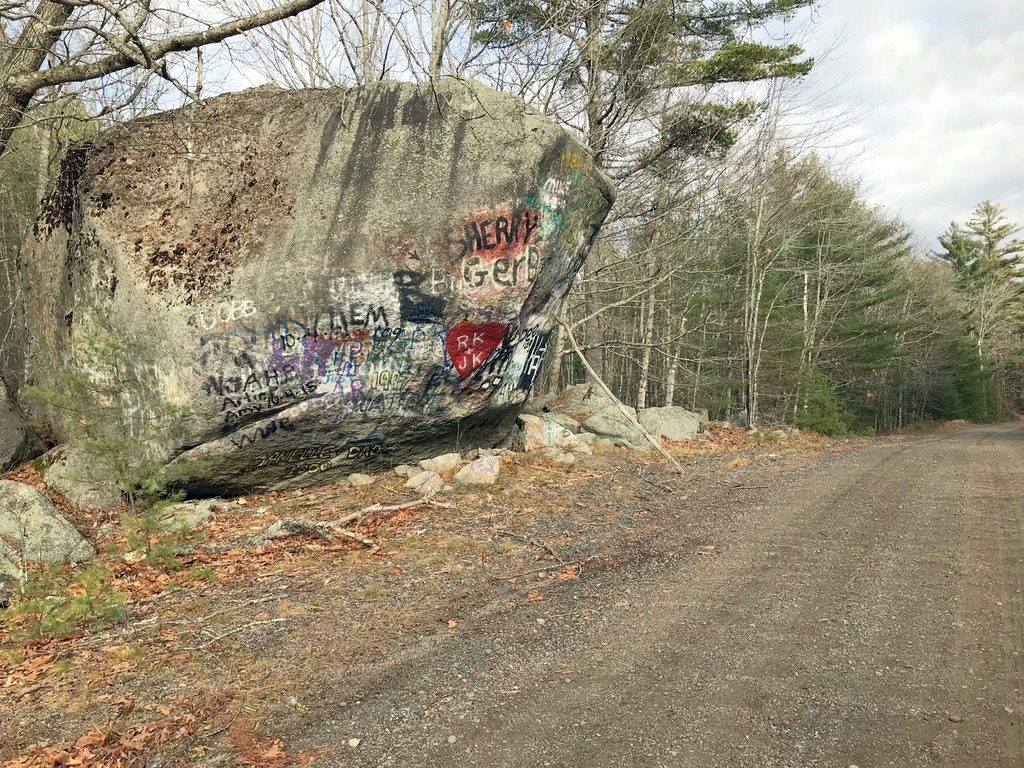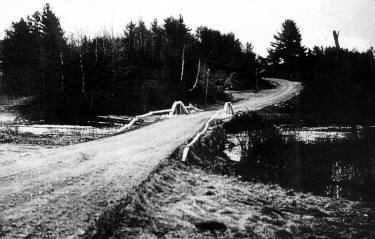
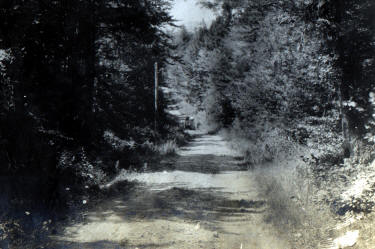
Today a drive over the Airline is a breeze, the road is entirely paved, near switchbacks and 90 degree turns have been removed and there are long passing lanes on hills which in the past were often the site of long lines of traffic behind 10 campers struggling at 20 miles an hour to make the grade.
Today there is little traffic even on a busy day. The road wasn’t always in such good shape of course, and many of us remember as far back in the 50s and 60s when the Airline was still not entirely paved. The photos above show the Airline even earlier, the first in 1936 in Aurora and the second an even earlier photo of the Airline in Alexander. The road was a challenge on a good day and downright dangerous in winter or after heavy rains when large portions of the road and bridges were often washed out. There are many harrowing accounts of trips over the Airline and we came across one recently which we’ll share. Walter Ellsmore, said to be from Portland but apparently a local man and two women, Mrs. Phyllis Normand and Mrs. John King, of South Portland, were on their way to Calais for a Christmas visit with the King family on Harrison Street in Calais. After visiting relatives in Bangor on Thursday December 23rd, 1943 they left for Calais late in the day choosing to drive the Airline, unaware apparently that the road had been plowed only to Township 22, about 30 miles from Bangor.
The Bangor Daily of December 27, 1943 describes what happened
3 Recovering After Being Marooned In Snow 36 Hours
Two women and a man are recovering today after a grueling 36 hours spent partly in a marooned car and partly in an abandoned lumber camp on the Bangor-Calais airline highway when the car in which they were driving from Bangor to Calais became stuck in deep snowdrifts on an unplowed section of the road.
Walter Ellsmore 33 United States Maritime Commission electrical inspector at the South Portland shipyards is in Eastern Maine General hospital with frozen feet and is well on the road to recovery. Mrs. Phyllis Normand 38 of 10 Alder Street South Portland and Mrs. John W King Cashing Village South Portland were both treated at Eastern Maine General hospital and discharged.
The trio were discovered early Saturday morning by State Trooper Dominique LaChance and Inland Fisheries and Game Warden Fred J. Reeves of Bangor acting on a report telephoned to the barracks of Troop E State Police here at 10 o’clock Friday night.
LEFT HERE THURSDAY
The trio it appears left South Portland sometime late Thursday and drove to Bangor where they made a pre-Christmas visit with some relatives including Mrs. Hazen King of 717 Main Street. They then started for Calais to spend Christmas with other relatives. The airline between Bangor and Calais which they chose as their route had been plowed only to a point in Township 22 near Bald Mountain where a road turned off to a lumber operation. The car driven by Ellsmore plunged on through the end of the plowed highway into unplowed road and came to a stop in drifted snow some 200 yards from the end of the plowed road. Ellsmore in attempting to back the car out of the predicament in which he found himself burned out his clutch and the car became useless.
The three spent the night in the car and near a fire which Ellsmore kindled close by. Ellsmore’s feet became wet from plowing through the snow back into the woods nearby in securing branches and limbs with which he kept the fire going throughout most of the night. During the night he fired between 20 and 30 shotgun shells in an attempt to attract attention, but State police said yesterday there is no house or even occupied camp within ten miles of the spot where they were marooned.
WALKED BACK
The next morning the three started back down the road in the direction of Amherst and after walking for five miles came upon an abandoned lumber camp at the side of the road. They broke into the lumber camp and started a fire and were fairly comfortable through Friday and Friday night although they had no food of any kind. Ellsmore ‘s feet began to swell after he got into the warmth of the lumber camp and within a few hours he was unable to walk at all.
Friday night was spent in the lumber camp and early Saturday morning the two women started to walk back to the car to get their money and cigarettes and other necessities out of it. They had gone about three miles when they were overtaken by LaChance and Reeves who took them on to the car, ascertained it was broken down beyond immediate repair, secured their effects and returned to the lumber camp. Here they found it necessary to carry Ellsmore out of the camp to the car and then they immediately took the three to the Eastern Maine General Hospital.
The point at which the three were marooned is in one of the most desolate sections of this part of Maine. It is about six miles beyond Shoppe’s Inn and near Bald Mountain in a countryside completely woods covered.
CAPTAIN UPTON’S STATEMENT
Although the call came into the State Police barracks here at 10 o’clock the police did not start out over the road looking for the party until 8 o’clock Saturday morning. The report was made to the barracks here by Mrs. Hazen King who had ascertained that the three had not yet arrived at Calais. The police acted on the assumption that the car had gone off the road and decided that it could not be found at night. The fact that the State Police did not get started until the next morning drew fire from Counselor Leroy Higgins of South Portland said to be a relative of one of the marooned trio who declared he would take the matter up with Governor Sumner Sewall and demand an investigation of the State Police.
Captain Lawrence Upton of the Maine State police acting chief said last night however that he did not believe the State police here had made any mistake. “In some cases we do err in judgment” Captain Upton said “but this isn’t one of them. I believe the way this case was handled by Sgt George Dyer and his men at the Bangor barracks was all right”. When the State police did start on the case they moved with all dispatch. Trooper Gibson left Calais immediately in an attempt to come in over the airline but could get no farther than Wesley. Trooper Lindsay started from Cherryfield and arrived at the abandoned car after Trooper LaChance and Game Warden Reeves had found the three and effected a rescue.
It is a little surprising that these folks were not warned about the condition of the road or perhaps they were and decided to take a chance. The Airline was 50 miles shorter than the coastal route and was always a temptation to be brave or foolhardy back in those days. We do find it interesting that when the women left the safety and warmth of the camp it appears that rather than walk toward Bangor and a possible rescue they walk back to the car to retrieve their cigarettes.
The incident caused a good deal of controversy. As noted above a relative of the travelers from South Portland with some political pull charged the State Police with being lax in their rescue efforts as they waited several hours after being alerted to the lost car before venturing down the Airline to find them. The State Police took umbrage at the charge and concluded after an official investigation that they had acted properly. They pointed out that the family had waited 26 hours to report the missing relatives and by then it was dark and a search could well have missed the car.
In an interesting afterward Bud Leavitt’s column of November 25, 1952 mentions the incident. Bud, whose columns often reported on hunting and fishing adventures on the Airline wrote:
A guy with a large circle of friends, Guide Walter Ellsmore of Grand Lake Stream, is anything but comfortable at the Hyde Memorial Hospital in Bath. The fellow is suffering from an injury, which in itself, is quite a story. Years ago Walt was one of several dozen people snowbound for days on the Bangor-Calais Airline Road. Both feet were frozen. The present hospitalization, actually, turns out to be the after effects of that nightmarish experience.We’ll point out here the recurring problem with accounts separated by years from the actual events-they must be taken with several grains of salt.
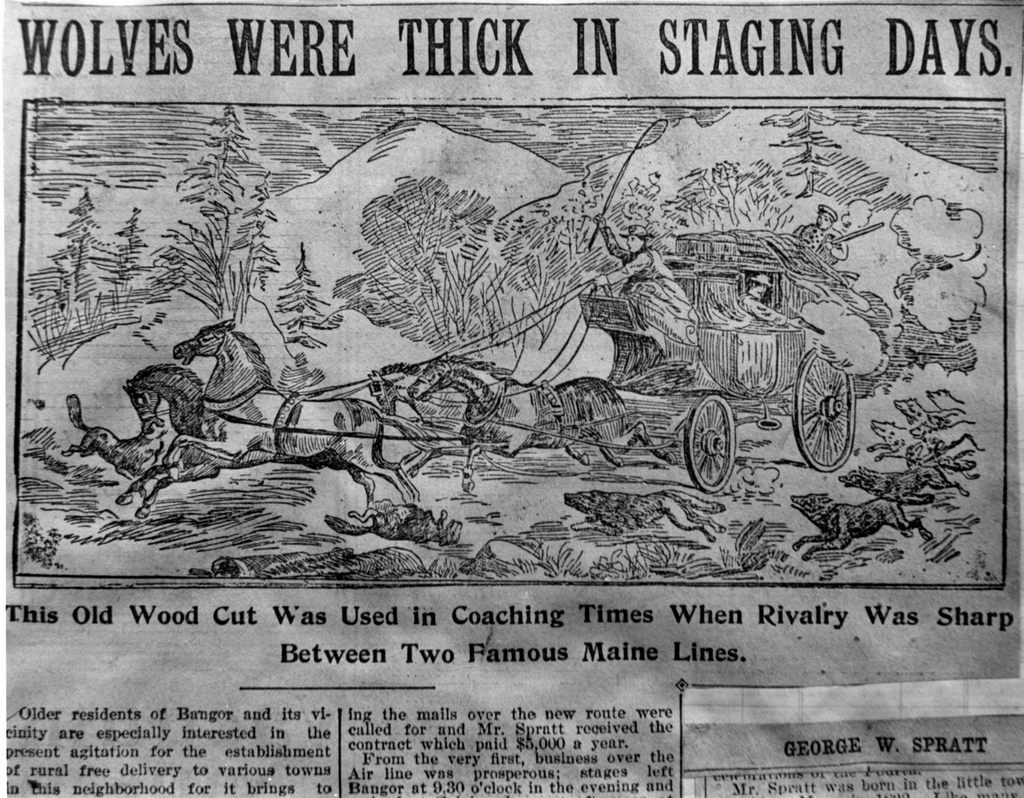
In the early days the Airline was known as the “Wolf Route ” because in 1857 the “Airline Stage Company ” bested the Shore Line Stage Company which ran along the coast for the Downeast mail contract. The Shore Line folks were furious and tried to convince passengers that saving six hours of travel was hardly worth it if you were likely to be devoured by a wolf somewhere between Amherst and Wesley. The Shore Line owners put the above woodcut in newspapers to warn the traveling public of the dangers of the Airline but in the end the PR campaign failed. One would have thought that would have been the end of the competition between the Shore Line and the Airline but it wasn’t. In fact the competition was even fiercer in the late 1950s and 1960s when the Airline was nearly completely paved. The “Route 1” boosters didn’t want tens of thousands of cars bypassing their businesses on their way to Canada even though the route through Ellsworth and Machias was far longer. They fought the funding of repairs to the road and bridges on the Airline and disparaged the Airline in the press. They were successful to some extent, many travelers were leery of the Airline and took the coastal route. Even locals often preferred the route through Lincoln when going to Bangor.
The battle went on for 20 years in the courts and the press and, in the mid 1960s, the Airline Highway Association was formed to promote travel on the Airline. According to one history ” Its members sought television and newspaper coverage and erected a large billboard just across the border in St. Stephen urging travelers to take the Airline.” It was 50 miles shorter, they pointed out, and ” much more scenic, and the people, the sign claimed, were much more friendly.”
In 1957 Jay Hinson, then writing for the Bangor Daily, conducted a survey of travelers on the Airline and Route 1 to assess opinions of those traveling the respective routes. The article, which is too long to reproduce here, stated in part:
Jay Hinson 1957: Bangor Daily News
Airline’ Road Better With Years- Competing With Route One For Traffic
By JAY HINSON CALAIS July 11
Each winter in Washington county it has been the custom for business Interests along Route One the county’s main artery to wage a friendly battle of words with business interests such as merchants, gas station operators and motel owners along Route Nine regarding the directing of tourist traffic which flows heavily through the county bound to and from the Maritime Provinces of Canada. Although immense improvement has been made on Route One in the last three years much work has also been accomplished on the “Airline” so that as of May there are only about 10 miles of unpaved highway on the road which is about 50 miles shorter than Route One from Calais to Bangor. With its improvement and directness therefore Route Nine is presenting definite competition to Route One as far as traffic volume is concerned. In an effort to arrive at some conclusions The NEWS Washington County bureau conducted a very informal survey this week on both routes and asked these two questions of tourists: “Why did you take Route One? or Route Nine?” and “What is your candid opinion of the road’s condition.
As to the Airline the opinions were varied:
“lots of ups and downs;” “very narrow in spots;” “nice forest and hill scenery;” “can stand much improvement;” “better than ever;” “nothing to complain about;” “as to scenery, some of the nicest I’ve seen;” “ not commercialized;” “terrible;” “some nice vistas but I knocked my muffler off;” “a roller coaster;” “not bad at all.”
While the above does not seem a ringing endorsement of the Airline, the comments of those traveling Route 1 were quite similar and we know in the end the Airline was victorious.
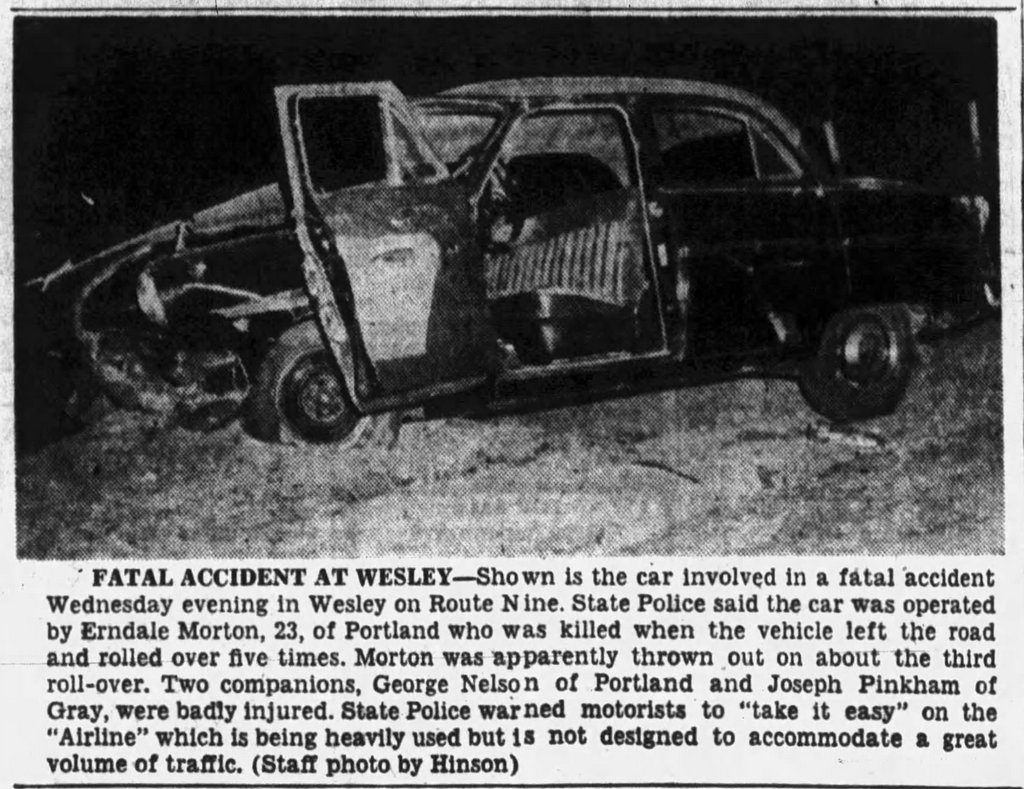
It must be admitted however that the Route 1 folks did have a point in the 1950s and 60s about the Airline still being quite a challenge. As late as 1967 the State Police warned travelers to “take it easy” as the Airline was “heavily used and not designed to accommodate a great volume of traffic.”
The curves were sharp and treacherous, there were no breakdown lanes so the Maine forest was sometimes within reach out the window. If your vehicle broke down, and vehicles were notoriously undependable in those days, one had to hope the next car around the curve wasn’t a hopped up V-8 driven by a kid trying to set a new record from Baileyville to the Brewer end of the Airline. Such contests were common in the 60s with one Calais racer claiming to have driven the Airline in under an hour.
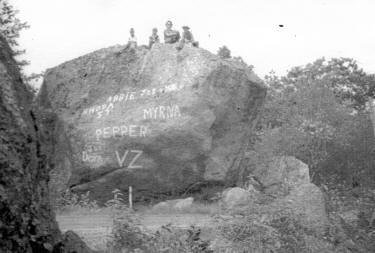
The road also ran within a couple of feet of such immovable obstacles as the famous “rock” and cars were overpowered and capable of higher speeds than was safe on any road but especially the airline. The Whaleback was a particular terror for some, narrow and with nothing between the side of the car and oblivion, reports of cars and trucks disappearing over the edge, although exaggerated, were not uncommon. Lost parties were sometimes reported, usually in winter. The Vermont Barre Times headlines on December 3 1945 read: “PLOWS TRY TO GET MAROONED MAINE HUNTERS. BORING THROUGH SNOWDRIFTS TO REACH GROUP NEAR MACHIAS RIVER. HORSES TRUCKS IN RESCUE WORK. SEARCH CONTINUES FOR HUNTERS LOST AFTER STORM.
Another issue with Airline in its early days was closures even in the middle of summer. In 1923 it was closed for nearly a month from Beddington to Wesley because the bridges had washed out and shorter closures at any time of the year were common, even forest fires would close the road.
Finally a few things you probably didn’t know about the Airline but which we plan to tell you anyway:
Maine’s tiniest town was located on the Airline. In 1962 Beddington had 19 residents. There was no electricity although there was local telephone service. A call to Bangor had to be channeled through the Warden Station on Lead Mountain and, according to the Bangor Daily it “still takes as much as two days to get a telephone message from Bangor to Beddington – a distance of 40 miles.”
In 1887, 30 years after the Airline Stage made its first run and had defeated the competitors of the Shore Line route another challenger arose- a self propelling steam engine. According to the Bangor Whig and Courier this steam engine “intends to travel this route and do the passenger and general transportation business which has so much increased since the Air-Line Stage was put on. ” While seemingly admitting the proposal had merit as “wood and water for the steam engine is plentiful along the Airline” they paper did sympathize with the plight of the stage line which the paper points out “have faithfully fulfilled their mail contract and served the public fully to their satisfaction, as well as cleared out the pack of wolves which once infested the road.” As far as we know the “self-propelling steam engine” never left the shop.
One of the challenges of the Airline on the Baileyville end was Day Hill in Wesley which burned out innumerable clutches and brakes about halfway up or down the hill. Some vehicles simply didn’t have the power to climb the hill such as the Greyhound bus from Calais to Bangor in 1959. On the way up the bus, unlike the little engine that could, couldn’t and the brakes having failed the bus began back down the hill at an alarming rate, backwards of course, filled with 40 very concerned passengers. The driver acted quickly and “ditched the bus after it had traveled about 60 yards”. There were no injuries.
John Dudley whose history of the Airline is a masterpiece tells us that in 1943 when the incident first described above occurred the Airline was still entirely dirt, at least at the Baileyville end. It wasn’t until the 1950s that the Baileyville end of the road saw any pavement and it wasn’t until the mid 1960s that the entire road was paved. Those braving the Airline often took at least one extra spare tire, often two. In the early 50s Ross Sadler, who lived about a mile out the Airline from the corner of Route 1, finally persuaded the town fathers to pave the mile to his house but the rest of the road remained dirt for several years. John recalls going to his grandfather’s camp in Alexander before any of the road was paved. At the bottom of the hill by the cemetery everyone got out and walked out the steep hill while his grandfather, Herbert Dudley, backed up the hill. In those days cars had no fuel pumps and without gravity to feed the engine cars would simply stop so when traveling the Airline in the early days of the automobile passengers often had to walk while the driver backed up the hills.
Finally a couple of nostalgic photos:
